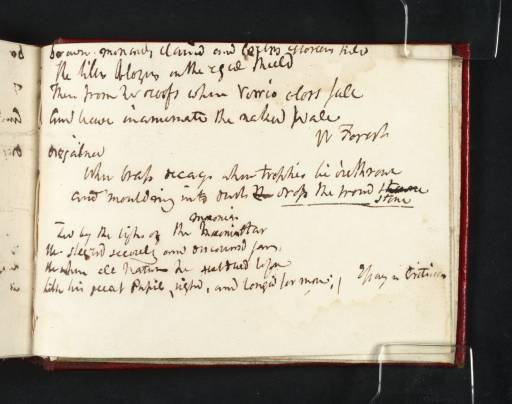Written with the sketchbook inverted, Turner’s inscriptions read:
Drawn Monarchs chaind and Crecy’s glorious field
The lilies blazing on the regal shield
Then from her roofs where Verrio colors fall
And leave inanimate the glorious wall
W Forest
When brass decays when trophies lie dethrown
And mouldering into dust drop the proud stone
Led by the lights of the Maonian [Maeonian inserted] Star
He steered securely and discovered far
He when all nature he subdued before
Like his great Pupil, sighd, and longed for more
Essay on Criticism
These texts are based on Alexander Pope. The first is from a passage in Windsor Forest (1713) in which Pope associates history, heraldry and art. In the original poem, ‘Monarchs chain’d, and Cressi’s glorious field’ refer to David II, King of Scotland, taken prisoner at the Battle of Neville’s Cross and King John of France, captured by Edward, the Black Prince at the Battle of Poitiers, both in 1356, and the Battle of Crécy, 1346; ‘lillies blazing’ are the lilies of England which Edward III quartered with the leopards of France when he assumed the title of King of France; and ‘Verrio’s colours’ are the paintings by Antonio Verrio (1639–1707) of the Black Prince leading the French king into captivity, in St George’s Hall, Windsor, which were falling into decay. The second main passage is based on An Essay on Criticism (1711), and includes both a garbled version of Pope’s couplet alluding to the poet Homer, ‘He steered securely, and discovered far / Led by the light of Maeonian Star’, and of his addition to be inserted between lines 648–9, ‘He, whom all Nature has subdued before / Like his great pupil, sighed, and longed for more’.
David Blayney Brown
July 2009

